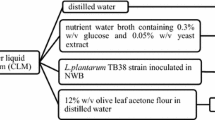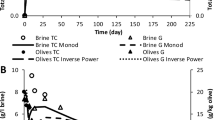Abstract
Olive fruits of the Gemlik variety harvested from different regions of Turkey were placed in aseptic or non-aseptic brines containing 6 % NaCl. Olives of non-aseptic treatment were left to spontaneously ferment under anaerobic conditions. Samples for microbiological and chemical analysis were taken periodically during the course of the fermentation. No lactic acid bacteria growth was observed in three of the six samples, and yeasts were the prevailing microbial group in the other samples. Brines were analyzed for fermentable substrates (glucose, fructose, sucrose and mannitol), fermentation products (organic acids and ethanol) and phenolic–oleosidic compounds. Most of the unprocessed fruits had a low concentration of oleuropein. Hydroxytyrosol and oleoside 11-methyl ester were the main phenolic and oleosidic compounds in all brines. Likewise, the content of antimicrobials such as the dialdehyde form of decarboxymethyl elenolic acid, either free or linked to hydroxytyrosol, in brines was very low, which may permit the growth of lactic acid bacteria in these media. A growth test with two strains of Lactobacillus plantarum was applied to aseptic brines of all samples to determine whether these compounds inhibited lactic acid bacteria growth. The results of this study indicated that Gemlik olive is a “sweet” variety with a low antimicrobial compound content that can be fermented by lactic acid bacteria under favorable conditions.

Similar content being viewed by others
References
Directorate of Turkish Olive Research Station (2012) İzmir, Turkey. http://www.zae.gov.tr. Accessed 23 May 2012
Aktan N, Kalkan H (1999) Table olive technology. Ege University Press, Izmir in Turkish
Panagou EZ, Schillinger U, Franz CMAP, Nychas GJE (2008) Microbiological and biochemical profile of cv. Conservolea naturally black olives during controlled fermentation with selected strains of lactic acid bacteria. Food Microbiol 25:348–358
Kumral A, Basoglu F, Sahin I (2009) Effect of the use of different lactic starters on the microbiological and physicochemical characteristics of naturally black table olives of Gemlik cultivar. J Food Process Preserv 33:651–664
Medina E, Brenes M, Romero C, García A, de Castro A (2007) Main antimicrobial compounds in table olives. J Agric Food Chem 55:9817–9823
Medina E, Gori C, Servili M, de Castro A, Romero C, Brenes M (2010) Main variables affecting the lactic acid fermentation of table olives. Int J Food Sci Technol 45:1291–1296
Medina E, García A, Romero C, de Castro A, Brenes M (2009) Study of the anti-lactic acid bacteria compounds in table olives. Int J Food Sci Technol 44:1286–1291
Tassou CC, Panagou EZ, Katsaboxakis KZ (2002) Microbiological and physicochemical changes of naturally black olives fermented at different temperatures and NaCl levels in the brines. Food Microbiol 19:605–615
Romero C, García P, Brenes M, García A, Garrido A (2002) Phenolic compounds in natural black Spanish olive varieties. Eur Food Res Technol 215:489–496
Brenes M, de Castro A (1998) Transformation of oleuropein and it hydrolysis products during Spanish-style green olive fermentation. J Sci Food Agric 77:35–358
Ozay G, Borcakli M (1995) Effect of brine replacement and salt concentration on the fermentation of naturally black olives. Food Res Int 28:553–559
Nychas GJE, Panagou EZ, Parker ML, Waldron KW, Tassou CC (2002) Microbial colonization of naturally black olives during fermentation and associated biochemical activities in the cover brine. Lett Appl Microbiol 34:173–177
Arroyo-López FN, Querol A, Bautista-Gallego J, Garrido-Fernández A (2008) Role of yeasts in table olive production. Int J Food Microbiol 128:189–196
Kumral A, Basoglu F, Sahin I (2009) Effect of the use of different lactic starters on the microbiological and physicochemical characteristics of naturally black table olives of gemlik cultivar. J Food Process Preserv 33:651–664
Romero C, Brenes M, García P, García A, Garrido A (2004) Polyphenol changes during fermentation of naturally black olives. J Agric Food Chem 52:1973–1979
Amiot MJ, Fleuriet A, Macheix JJ (1986) Importance and evolution of phenolic compounds in olive during growth and maturation. J Agric Food Chem 34:823–826
Ruiz-Barba JL, Rios-Sánchez RM, Fedriani-Iriso C, Olías JM, Ríos JL, Jimenez–Diaz R (1990) Bactericidal effect of phenolic compound from green olives against Lactobacillus plantarum. Syst Appl Microbiol 13:199–205
Ruiz-Barba JL, Brenes-Balbuena M, Jimenez-Diaz R, García-García P, Garrido-Fernández A (1993) Inhibition of Lactobacillus plantarum by polyphenols extracted from two different kinds of olive brine. J Appl Bacteriol 74:15–19
Landete JM, Curiel JA, Rodríguez H, De las Rivas B, Muñoz R (2008) Study of the inhibitory activity of phenolic compounds found in olive products and their degradation by L. plantarum strains. Food Chem 107:30–326
Rodríguez H, Curiel JA, Landete JM, de las Rivas B, de Felipe FL, Gómez-Cordoves C, Mancheno JM, Muñoz R (2009) Food phenolics and lactic acid bacteria. Int J Food Microbiol 30:79–90
Acknowledgments
This work was supported by grants from the Higher Education Council of Turkey and project AGL 2009-07512 from the Spanish Government and European Union (European Regional Development Funds).
Author information
Authors and Affiliations
Corresponding author
Rights and permissions
About this article
Cite this article
Kumral, A., Korukluoglu, M., Romero, C. et al. Phenolic inhibitors involved in the natural fermentation of Gemlik cultivar black olives. Eur Food Res Technol 236, 101–107 (2013). https://doi.org/10.1007/s00217-012-1859-8
Received:
Revised:
Accepted:
Published:
Issue Date:
DOI: https://doi.org/10.1007/s00217-012-1859-8




